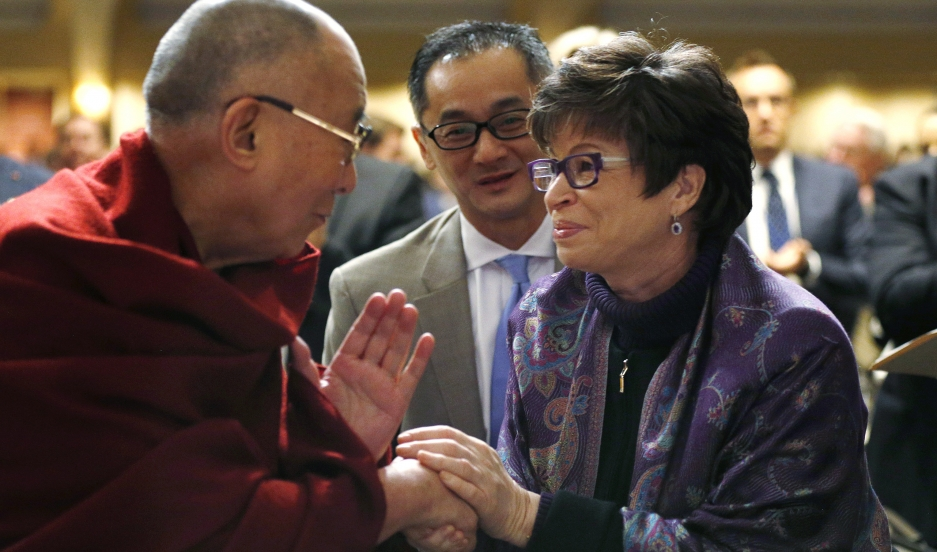
Valerie Jarrett speaks with His Holiness the Dalai Lama at the National Prayer Breakfast on February 5, 2015
She has written about the impact the Dalai Lama had in her life in her memoir, My Journey to the West Wing and the Path Forward, published in April 2019.
In his first year, President Barack Obama faced with developments that affected US relations with China that would have an impact on US relationship with His Holiness the Dalai Lama (I will dwell on this more later). As part of the resolution of the issue, Ms. Jarrett (and the newly designated, but not announced, U.S. Special Coordinator for Tibetan Issues, Maria Otero) ended up flying to Dharamsala in India in September 2009 to call on His Holiness.
I will let her memoir take it up from here. She says, “When I returned to DC, I told the president that the Dalai Lama had changed my life. If his spirit could be so positive and hopeful in the face of fifty years living with his people in exile, I should have no complaints.” She then compares the Dalai Lama to two other personalities who have touched her deeply: “He had the same generous spirit I saw in Elie Wiesel when we had visited Buchenwald, a spirit I’d also seen once before back in city hall in Chicago, when we received a visit from Nelson Mandela.”
She then recalls this incident when the Dalai Lama visited Washington, D.C. in February 2010: “Several months later, when the Dalai Lama did visit the president, I was so excited to see him again. After dealing with the frustrations of trying to work with the Republicans in Congress, I needed another infusion of his hopeful spirit. After President Obama greeted the Dalai Lama, he re-introduced him to me and told the Dalai Lama that I had said he had changed my life. The Dalai Lama’s eyes danced with delight, and, pausing first for effect, he announced with a belly laugh, “She exaggerates.”
Now to the background to this Dharamsala trip by these senior American officials. The years around 2009 were those in which the Dalai Lama made at least one annual visit, if not more, to the United States. Some months after President Obama assumed office in January 2009, there were talks of him making his first visit as President to China in November. That news came when preparations were already underway for a visit by the Dalai Lama to Washington, D.C, in October, to participate in programs, including a conference with scientists organized by the Mind & Life Institute.
Rinpoche took up with the White House the issue of a presidential meeting. It is public knowledge that His Holiness the Dalai Lama has a principled position not to cause inconvenience to leaders of countries that he visits and President Obama was no exception. Given that US-China relationship is something important, the US side wanted to request the postponement of a meeting with His Holiness to a period after the China trip. At the same time, the White House felt important to get His Holiness’s thoughts on what the President could convey to the Chinese leaders during the November trip. It was thus that Ms. Jarrett ended up going to Dharamsala on September 13 and 14 of 2009 to convey President Obama’s message to His Holiness.
Ms. Jarrett explains this in her memoir: “My work for the White House took me around the world and back, many times. Very early on, we heard that the Dalai Lama wanted to visit DC and call on President Obama. At the same time, we were trying to manage our relationship with China, and it would have caused diplomatic problems if the Dalai Lama, who China considered to be an enemy, came to visit the White House before they did. We had to try and think of a delicate way to ask the Dalai Lama to postpone his trip without giving offense. The national security team came up with the idea that I should go and hand-deliver a letter from the president to the Dalai Lama in Dharamsala, India, where he and thousands of other Tibetans have lived in exile for fifty years. The letter invited him to come in six months. We felt that the symbolism of someone close to President Obama making this trek would smooth over any ruffled feathers with the Dalai Lama, while not provoking any negative reaction from the Chinese.”
The Office of H.H. the Dalai Lama announced their visit to Dharamsala on September 14, 20109 saying, “US President Barack Obama’s emissary, Valerie Jarrett, called on His Holiness the Dalai Lama on September 13 & 14. She was accompanied by State Department Under Secretary Maria Otero, who she introduced formally to His Holiness as the designated new Special Coordinator for Tibetan Issues.” The statement also said, “His Holiness is looking forward to meeting President Obama after his visit to China.”
The International Campaign for Tibet carried a report on the visit on September 14, 2009. It quoted Rinpoche as saying, “His Holiness has shared with the US delegation his views about how the President can help the Tibetan people and he would value an opportunity to hear directly from the President about what transpired during the Beijing summit with regard to Tibet.”
President Obama and the Dalai Lama eventually met on February 18, 2010 with the White House issuing a statement saying, “The President met this morning at the White House with His Holiness the XIV Dalai Lama. The President stated his strong support for the preservation of Tibet’s unique religious, cultural and linguistic identity and the protection of human rights for Tibetans in the People’s Republic of China. The President commended the Dalai Lama’s “Middle Way” approach, his commitment to nonviolence and his pursuit of dialogue with the Chinese government. The President stressed that he has consistently encouraged both sides to engage in direct dialogue to resolve differences and was pleased to hear about the recent resumption of talks. The President and the Dalai Lama agreed on the importance of a positive and cooperative relationship between the United States and China.”
The White House had to face some criticism from members of congress, analysts and the media for the non-meeting in October 2009 as some saw this as kowtowing to the Chinese. Ms. Jarrett’s memoir explains from the Obama Administration’s perspective, the development leading to this.
While in Dharamsala, Ms. Jarrett was also touched by the babies at the Tibetan Children’s Village as well as other people she met. She writes, “We arrived a couple of days before the Dalai Lama, who was on his way back from Europe. He’d arranged for us to tour an orphanage filled with over five thousand children, all sent by Tibetan families to escape persecution in China and to be closer to their spiritual leader. The children were so well loved and happy. One of them grabbed my hand and took me to her immaculate room and showed me her stuffed animals. The woman giving me the tour had a special way with the children because she had been an orphan herself decades earlier. I visited with nuns who’d been incarcerated in Tibet because of their commitment to the Dalai Lama, and met with the men who’d escaped the Tibetan village and hid in the surrounding mountains while the Chinese government searched for them. We met with Buddhist monks who tended to the ancient manuscripts secured safely away in their monastery, and they told me the history of the Dalai Lama and why he meant so much to his people.”
Be that as it may, Ms. Jarrett concludes her experience meeting the Dalai Lama by comparing his life with that of Elie Wiesel and Nelson Mandela. She writes, “All three men had endured terrible ordeals, and not only had they not lost their will to live, but they never let those experiences warp their spirit or undermine their belief in the potential of all people to be good. Their empathy, warmth, and compassion always remained unshakably intact. They all had a genuine love for their fellow man, regardless of how their fellow man felt about them.”


In tears…I have a GREAT LOVE TO
HH DALAI LAMA…and I dream to TRAVEL to Dharamsala for HELPING “in some way”…the TIBETAN PEOPLE…
I have been in ÍNDIA twice …but never had the opportunity to go and help …